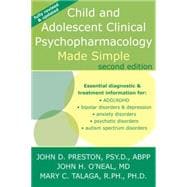Child and Adolescent Clinical Psychopharmacology Made Simple is the only resource parents and professionals need to consult for the most up-to-date information on medications for the treatment of children and teens suffering from psychological disorders.
Fully revised and updated, this second edition offers new research and information on psychoactive medications for autism, ADHD, child-onset bipolar disorder, and a variety of other common psychological conditions. Also included are fact sheets that clearly delineate frequently prescribed medications for each disorder along with medication side effects and signs of toxicity.
For each psychological disorder, the book offers:
-Current diagnostic criteria
-Treatment indications and contraindications
-Medication information
-Help for monitoring, evaluating, and following up with patients








